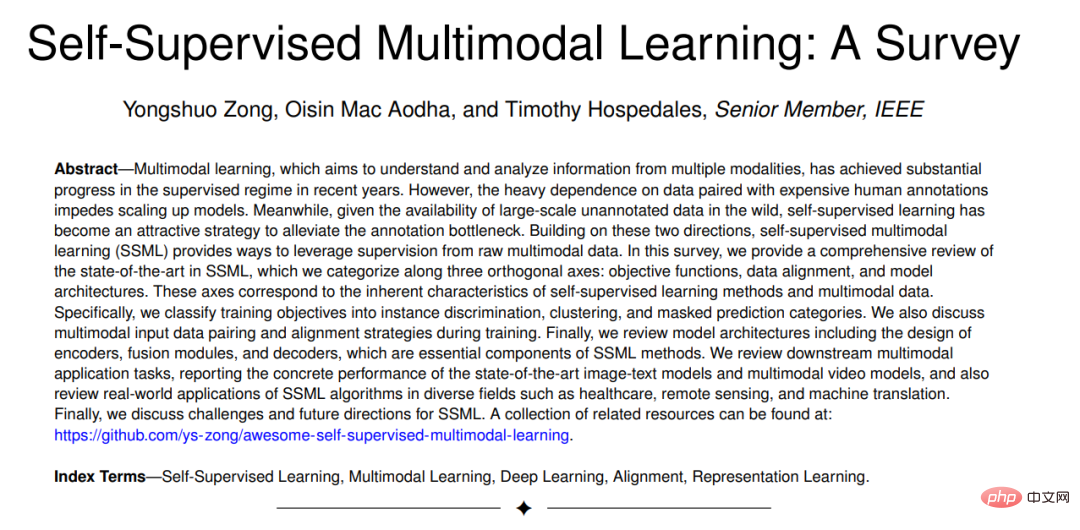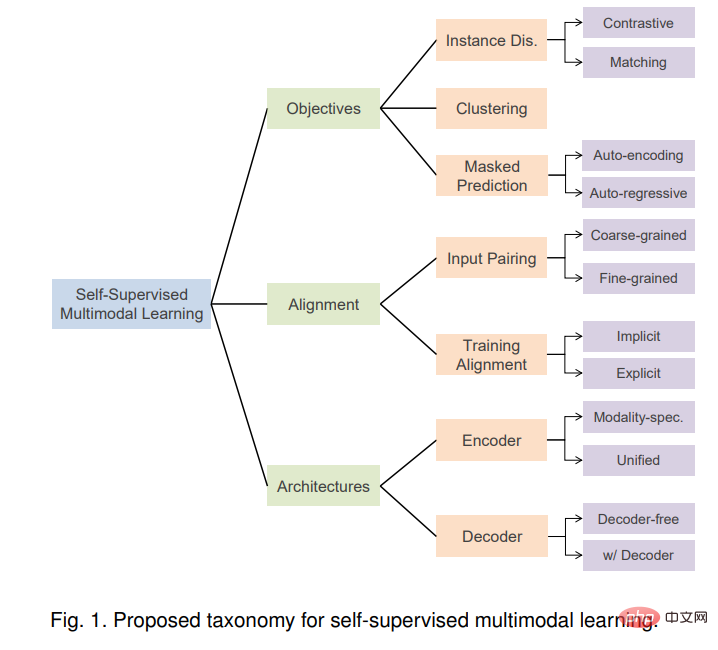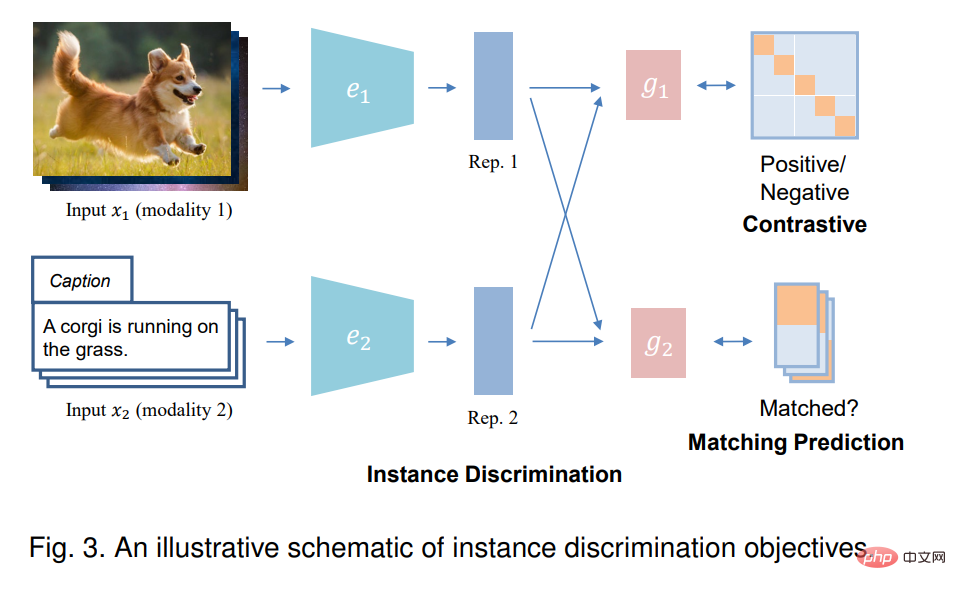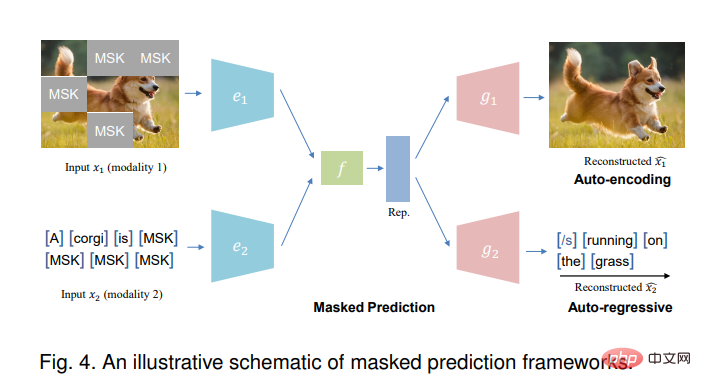 Technology peripherals
Technology peripherals
 AI
AI
 Multimodal self-supervised learning: exploring objective functions, data alignment and model architecture - taking the latest Edinburgh review as an example
Multimodal self-supervised learning: exploring objective functions, data alignment and model architecture - taking the latest Edinburgh review as an example
Multimodal self-supervised learning: exploring objective functions, data alignment and model architecture - taking the latest Edinburgh review as an example
Multimodal learning aims to understand and analyze information from multiple modalities, and substantial progress has been made in supervision mechanisms in recent years.
#However, heavy reliance on data combined with expensive manual annotation hinders model scaling. At the same time, given the availability of large-scale unlabeled data in the real world, self-supervised learning has become an attractive strategy to alleviate the labeling bottleneck.
Based on these two directions, self-supervised multimodal learning (SSML) provides a method to exploit supervision from original multimodal data.

##Paper address: https ://arxiv.org/abs/2304.01008
##Project address: https://github. com/ys-zong/awesome-self-supervised-multimodal-learning
In this review, we provide a comprehensive review of the state-of-the-art techniques for SSML , we classify along three orthogonal axes: objective function, data alignment, and model architecture. These axes correspond to the inherent characteristics of self-supervised learning methods and multi-modal data.
Specifically, we divide the training objectives into instance discrimination, clustering and mask prediction categories. We also discuss multimodal input data pairing and alignment strategies during training. Finally, the model architecture is reviewed, including the design of encoders, fusion modules, and decoders, which are important components of SSML methods.Reviews the downstream multi-modal application tasks, reports the specific performance of the state-of-the-art image-text model and multi-modal video model, and also reviews the application of SSML algorithms in different fields Practical applications such as healthcare, remote sensing and machine translation. Finally, challenges and future directions for SSML are discussed.
1. Introduction
Humans
perceive the world through various senses, including vision, hearing, touch and smell. We gain a comprehensive understanding of our surroundings by leveraging complementary information from each modality. AI research has been focused on developing intelligent agents that mimic human behavior and understand the world in a similar way. To this end, the field of multimodal machine learning [1], [2] aims to develop models that can process and integrate data from multiple different modalities. In recent years, multimodal learning has made significant progress, leading to a series of applications in visual and language learning [3], video understanding [4], [5], biomedicine [6], autonomous driving [7] and other fields. More fundamentally, multimodal learning is advancing long-standing grounding problems in artificial intelligence [8], bringing us closer to more general artificial intelligence.However, multi-modal algorithms often still require expensive manual annotation for effective training, which hinders their expansion. Recently, self-supervised learning (SSL) [9], [10] has begun to alleviate this problem by generating supervision from readily available annotated data. Self-supervision in single-modal learning is fairly well defined and depends only on the training objectives and whether human annotation is used for supervision. However, in the context of multimodal learning, its definition is more nuanced. In multimodal learning, one modality often acts as a supervisory signal for another modality. In terms of the goal of upward scaling by eliminating the manual annotation bottleneck, a key issue in defining the scope of self-supervision is whether cross-modal pairings are freely acquired.
Self-supervised multimodal learning (SSML) significantly enhances the capabilities of multimodal models by leveraging freely available multimodal data and self-supervised objectives.
In this review, we review the SSML algorithm and its applications. We decompose the various methods along three orthogonal axes: objective function, data alignment, and model architecture. These axes correspond to the characteristics of self-supervised learning algorithms and the specific considerations required for multimodal data. Figure 1 provides an overview of the proposed taxonomy. Based on the pre-task, we divide the training objectives into instance discrimination, clustering and mask prediction categories. Hybrid approaches that combine two or more of these approaches are also discussed. Unique to multimodal self-supervision is the problem of multimodal data pairing. Pairings, or more generally alignments, between modalities can be exploited by SSML algorithms as input (e.g. when one modality is used to provide supervision for another), but also as output (e.g. , learns from unpaired data and induces pairing as a by-product). We discuss the different roles of alignment at coarse-grained levels that are often assumed to be freely available in multimodal self-supervision (e.g., web-crawled images and captions [11]); sometimes explicitly or Implicitly induced fine-grained alignment (e.g., correspondence between title words and image patches [12]). Additionally, we explore the intersection of objective functions and data alignment assumptions. also analyzes the design of contemporary SSML model architecture. Specifically, we consider the design space of encoder and fusion modules, comparing mode-specific encoders (without fusion or with late fusion) and unified encoders with early fusion. We also examine architectures with specific decoder designs and discuss the impact of these design choices. Finally, the applications of these algorithms in multiple real-world domains, including healthcare, remote sensing, machine translation, etc., are discussed, and the technical challenges and social impacts of SSML are discussed in depth. , indicating potential future research directions. We summarize recent advances in methods, datasets, and implementations to provide a starting point for researchers and practitioners in the field. Existing review papers either only focus on supervised multimodal learning [1], [2], [13], [14], or single modality Self-supervised learning [9], [10], [15], or a certain sub-area of SSML, such as visual-linguistic pre-training [16]. The most relevant review is [17], but it focuses more on temporal data and ignores the key considerations of multi-modal self-supervision of alignment and architecture. In contrast, we provide a comprehensive and up-to-date overview of SSML algorithms and provide a new taxonomy covering algorithms, data, and architecture. Self-supervision in multi-modal learning We first describe the scope of SSML considered in this survey, as this term has been used inconsistently in previous literature. Defining self-supervision in a single-modal context is more straightforward by invoking the label-free nature of different pretext tasks, e.g., the well-known instance discrimination [20] or the masked prediction target [21] implement self-supervision. In contrast, the situation in multimodal learning is more complicated because the roles of modality and label become blurred. For example, in supervised image captioning [22], text is usually treated as a label, but in self-supervised multi-modal visual and language representation learning [11], text is treated as an input modality. In the multimodal context, the term self-supervision has been used to refer to at least four situations: (1) Label-free learning from automatically paired multimodal data— — such as movies with video and audio tracks [23], or image and depth data from RGBD cameras [24]. (2) Learning from multimodal data, in which one modality has been manually annotated, or two modalities have been manually paired, but this annotation has been created for a different purpose, and therefore can be considered free for SSML pre-training. For example, matching image-caption pairs scraped from the web, as used in the seminal CLIP [11], is actually an example of supervised metric learning [25], [26] where the pairing is supervised. However, since both patterns and pairings are freely available at scale, it is often described as self-supervised. This uncurated, incidentally created data is often of lower quality and noisier than specially curated datasets such as COCO [22] and Visual Genome [27]. (3) Learn from high-quality purpose-annotated multi-modal data (e.g., manually captioned images in COCO [22]), but with a self-supervised style objective such as Pixel-BERT [28]. (4) Finally, there are “self-supervised” methods that use a mixture of free and manually labeled multi-modal data [29], [30]. For the purpose of this investigation, we follow the idea of self-supervision and aim to scale up by breaking the bottleneck of manual annotation. Therefore, we include the first two categories and the fourth category of methods in terms of being able to train on freely available data. We exclude methods shown only for manually curated datasets because they apply typical “self-supervision” objectives on curated datasets (e.g., masked prediction). (a) Supervised multi-modal learning and (b) Self-supervised Learning paradigm of multi-modal learning: self-supervised pre-training without manual annotation (top); supervise and fine-tune downstream tasks (bottom). In this section, we will introduce the objective function used to train three types of self-supervised multi-modal algorithms: instance discrimination , clustering and masking predictions. Finally we also discussed hybrid targets. 3.1 Instance discrimination In single-mode learning, instance discrimination (ID) converts the original data into Each instance in is treated as a separate class, and the model is trained to distinguish between different instances. In the context of multimodal learning, instance discrimination usually aims to determine whether samples from two input modalities are from the same instance, i.e., paired. By doing so, it attempts to align the representation space of pairs of patterns while pushing the representation space of different pairs of instances further apart. There are two types of instance recognition goals: contrastive prediction and matching prediction, depending on how the input is sampled. ##3.2 Clustering The clustering method assumes that the trained End-to-end clustering will result in grouping data based on semantically salient features. In practice, these methods iteratively predict cluster assignments of encoded representations and use these predictions (also known as pseudo-labels) as supervisory signals to update feature representations. Multimodal clustering provides the opportunity to learn multimodal representations and also improve traditional clustering by supervising other modalities using pseudo-labels for each modality. 3.3 Mask prediction The mask prediction task can use automatic encoding (similar to BERT[101]) or autoregression method (similar to GPT [102]) to perform. 
2. Background knowledge

3. Objective function



 ##
##
The above is the detailed content of Multimodal self-supervised learning: exploring objective functions, data alignment and model architecture - taking the latest Edinburgh review as an example. For more information, please follow other related articles on the PHP Chinese website!

Hot AI Tools

Undresser.AI Undress
AI-powered app for creating realistic nude photos

AI Clothes Remover
Online AI tool for removing clothes from photos.

Undress AI Tool
Undress images for free

Clothoff.io
AI clothes remover

AI Hentai Generator
Generate AI Hentai for free.

Hot Article

Hot Tools

Notepad++7.3.1
Easy-to-use and free code editor

SublimeText3 Chinese version
Chinese version, very easy to use

Zend Studio 13.0.1
Powerful PHP integrated development environment

Dreamweaver CS6
Visual web development tools

SublimeText3 Mac version
God-level code editing software (SublimeText3)

Hot Topics
 1378
1378
 52
52
 The world's most powerful open source MoE model is here, with Chinese capabilities comparable to GPT-4, and the price is only nearly one percent of GPT-4-Turbo
May 07, 2024 pm 04:13 PM
The world's most powerful open source MoE model is here, with Chinese capabilities comparable to GPT-4, and the price is only nearly one percent of GPT-4-Turbo
May 07, 2024 pm 04:13 PM
Imagine an artificial intelligence model that not only has the ability to surpass traditional computing, but also achieves more efficient performance at a lower cost. This is not science fiction, DeepSeek-V2[1], the world’s most powerful open source MoE model is here. DeepSeek-V2 is a powerful mixture of experts (MoE) language model with the characteristics of economical training and efficient inference. It consists of 236B parameters, 21B of which are used to activate each marker. Compared with DeepSeek67B, DeepSeek-V2 has stronger performance, while saving 42.5% of training costs, reducing KV cache by 93.3%, and increasing the maximum generation throughput to 5.76 times. DeepSeek is a company exploring general artificial intelligence
 AI subverts mathematical research! Fields Medal winner and Chinese-American mathematician led 11 top-ranked papers | Liked by Terence Tao
Apr 09, 2024 am 11:52 AM
AI subverts mathematical research! Fields Medal winner and Chinese-American mathematician led 11 top-ranked papers | Liked by Terence Tao
Apr 09, 2024 am 11:52 AM
AI is indeed changing mathematics. Recently, Tao Zhexuan, who has been paying close attention to this issue, forwarded the latest issue of "Bulletin of the American Mathematical Society" (Bulletin of the American Mathematical Society). Focusing on the topic "Will machines change mathematics?", many mathematicians expressed their opinions. The whole process was full of sparks, hardcore and exciting. The author has a strong lineup, including Fields Medal winner Akshay Venkatesh, Chinese mathematician Zheng Lejun, NYU computer scientist Ernest Davis and many other well-known scholars in the industry. The world of AI has changed dramatically. You know, many of these articles were submitted a year ago.
 Google is ecstatic: JAX performance surpasses Pytorch and TensorFlow! It may become the fastest choice for GPU inference training
Apr 01, 2024 pm 07:46 PM
Google is ecstatic: JAX performance surpasses Pytorch and TensorFlow! It may become the fastest choice for GPU inference training
Apr 01, 2024 pm 07:46 PM
The performance of JAX, promoted by Google, has surpassed that of Pytorch and TensorFlow in recent benchmark tests, ranking first in 7 indicators. And the test was not done on the TPU with the best JAX performance. Although among developers, Pytorch is still more popular than Tensorflow. But in the future, perhaps more large models will be trained and run based on the JAX platform. Models Recently, the Keras team benchmarked three backends (TensorFlow, JAX, PyTorch) with the native PyTorch implementation and Keras2 with TensorFlow. First, they select a set of mainstream
 Hello, electric Atlas! Boston Dynamics robot comes back to life, 180-degree weird moves scare Musk
Apr 18, 2024 pm 07:58 PM
Hello, electric Atlas! Boston Dynamics robot comes back to life, 180-degree weird moves scare Musk
Apr 18, 2024 pm 07:58 PM
Boston Dynamics Atlas officially enters the era of electric robots! Yesterday, the hydraulic Atlas just "tearfully" withdrew from the stage of history. Today, Boston Dynamics announced that the electric Atlas is on the job. It seems that in the field of commercial humanoid robots, Boston Dynamics is determined to compete with Tesla. After the new video was released, it had already been viewed by more than one million people in just ten hours. The old people leave and new roles appear. This is a historical necessity. There is no doubt that this year is the explosive year of humanoid robots. Netizens commented: The advancement of robots has made this year's opening ceremony look like a human, and the degree of freedom is far greater than that of humans. But is this really not a horror movie? At the beginning of the video, Atlas is lying calmly on the ground, seemingly on his back. What follows is jaw-dropping
 KAN, which replaces MLP, has been extended to convolution by open source projects
Jun 01, 2024 pm 10:03 PM
KAN, which replaces MLP, has been extended to convolution by open source projects
Jun 01, 2024 pm 10:03 PM
Earlier this month, researchers from MIT and other institutions proposed a very promising alternative to MLP - KAN. KAN outperforms MLP in terms of accuracy and interpretability. And it can outperform MLP running with a larger number of parameters with a very small number of parameters. For example, the authors stated that they used KAN to reproduce DeepMind's results with a smaller network and a higher degree of automation. Specifically, DeepMind's MLP has about 300,000 parameters, while KAN only has about 200 parameters. KAN has a strong mathematical foundation like MLP. MLP is based on the universal approximation theorem, while KAN is based on the Kolmogorov-Arnold representation theorem. As shown in the figure below, KAN has
 Time Series Forecasting NLP Large Model New Work: Automatically Generate Implicit Prompts for Time Series Forecasting
Mar 18, 2024 am 09:20 AM
Time Series Forecasting NLP Large Model New Work: Automatically Generate Implicit Prompts for Time Series Forecasting
Mar 18, 2024 am 09:20 AM
Today I would like to share a recent research work from the University of Connecticut that proposes a method to align time series data with large natural language processing (NLP) models on the latent space to improve the performance of time series forecasting. The key to this method is to use latent spatial hints (prompts) to enhance the accuracy of time series predictions. Paper title: S2IP-LLM: SemanticSpaceInformedPromptLearningwithLLMforTimeSeriesForecasting Download address: https://arxiv.org/pdf/2403.05798v1.pdf 1. Large problem background model
 FisheyeDetNet: the first target detection algorithm based on fisheye camera
Apr 26, 2024 am 11:37 AM
FisheyeDetNet: the first target detection algorithm based on fisheye camera
Apr 26, 2024 am 11:37 AM
Target detection is a relatively mature problem in autonomous driving systems, among which pedestrian detection is one of the earliest algorithms to be deployed. Very comprehensive research has been carried out in most papers. However, distance perception using fisheye cameras for surround view is relatively less studied. Due to large radial distortion, standard bounding box representation is difficult to implement in fisheye cameras. To alleviate the above description, we explore extended bounding box, ellipse, and general polygon designs into polar/angular representations and define an instance segmentation mIOU metric to analyze these representations. The proposed model fisheyeDetNet with polygonal shape outperforms other models and simultaneously achieves 49.5% mAP on the Valeo fisheye camera dataset for autonomous driving
 Tesla robots work in factories, Musk: The degree of freedom of hands will reach 22 this year!
May 06, 2024 pm 04:13 PM
Tesla robots work in factories, Musk: The degree of freedom of hands will reach 22 this year!
May 06, 2024 pm 04:13 PM
The latest video of Tesla's robot Optimus is released, and it can already work in the factory. At normal speed, it sorts batteries (Tesla's 4680 batteries) like this: The official also released what it looks like at 20x speed - on a small "workstation", picking and picking and picking: This time it is released One of the highlights of the video is that Optimus completes this work in the factory, completely autonomously, without human intervention throughout the process. And from the perspective of Optimus, it can also pick up and place the crooked battery, focusing on automatic error correction: Regarding Optimus's hand, NVIDIA scientist Jim Fan gave a high evaluation: Optimus's hand is the world's five-fingered robot. One of the most dexterous. Its hands are not only tactile



